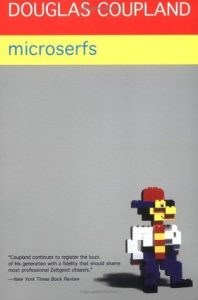
I came at this one almost exactly the same way that I did with Amy Thomson’s The Color of Distance. It was also a AlexLit recommendation, I blanched at the length, it was an author unfamiliar to me. But as soon as I started it, from page 1, rather than the 50 pages it took me to get into the Thomson, I was hooked.
Coupland is the voice of our generation, whatever our generation is: the first group of people to work with computers. This book is a codification of that heady feeling. It praises geekdom, while also shining a blinding white light at the superficiality of this most materialistic culture. It also gets underneath the surface of high tech low-lifes (and I don’t mean the cyberpunks–these are the geeks, the ones who stare at a monitor all day and all night, who never have time to make the score as a Gibson character) to show that even they are still human. Even geeks love. If you prick them, even they bleed.
The cultural references here are overwhelming. I predict in the future people will use this as a nostalgic device at parties. You can pull up almost any page and find enough brand name and object references to stun even the most jaded of computer nerds. To finish it off with, Coupland here explains his concept of Lego as the ultimate geek toy, something he has elaborated on recently in Wired magazine.
This is not just for those people who wonder what life as a Microsoft employee is like. While Coupland captures the feeling for a certain segment early in the book, it is only a portion of what he’s casting his net for. What he is really trying to do is show you what life for the young, computer literate college-aged is like, where the world is your oyster, and you prefer pizza.
[Finished December 1998]
